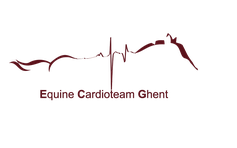Cardiology
Equine Cardioteam Ghent
State of the art equine cardiac examination and research is performed by the Equine CardioTeam Ghent. This team was founded in 2001 by Prof. Dr Gunther van Loon . In 2009, Prof. Dr. Annelies Decloedt joined the team.
The Equine Cardioteam is worldwide one of the leading teams to perform cardiac research and treat horses with cardiovascular disease.
3D electro-anatomical cardiac mapping
3D electro-anatomical cardiac mapping in an adult horse using Rhythmia (Boston Scientific). This advanced technique allows precise identification of the origin of an arrhythmia so that a targeted treatment by ablation can be performed.
Atrial fibrillation
- Implanted pacemakers were used to study the pathophysiology of atrial fibrillation.
- A new method, transvenous electrical cardioversion (TVEC) was developed to treat atrial fibrillation. During the procedure an electrical shock is delivered during general anaesthesia in order to restore normal cardiac rhythm immediately. Success rate is higher (95%) and complication rate lower compared to standard medical treatment.
- New echocardiographic techniques, such as 2D speckle tracking and Tissue Doppler Imaging, and registration of an intracardiac electrogram are used to assess atrial fibrillation susceptibility and prognosis.
2D speckle tracking (2D ST) and Tissue Doppler Imaging (TDI)
These are new ultrasonographic techniques for the quantification of atrial and ventricular myocardial function.
Pacing
A technique for cardiac electrical pacing in horses has been developed. This technique allows to stimulate the heart so that heart rate can be increased in case of bradycardia. The technique can be applied temporarily (temporary pacing) or permanently, by permanent implantation of a pacemaker. A technique for pacemaker implantation in equines was developed and is readily available for clinical patients.
Cardiac biomarkers
recent research has revealed new insights into the use of specific blood parameters for evaluation of cardiac function. Natriuretic peptides (ANP, proANP, NT-proANP, NT-proBNP,...) increase with cardiac dilatation and myocardial enzymes (cTn I, cTn T) increase with damage to the myocardium.
IntraCardiac Echography (ICE)
This technique is being used to obtain more detailed information of intracardiac structures.
